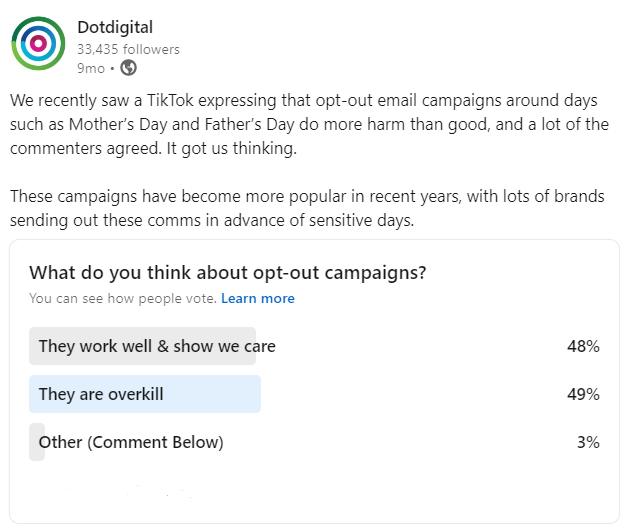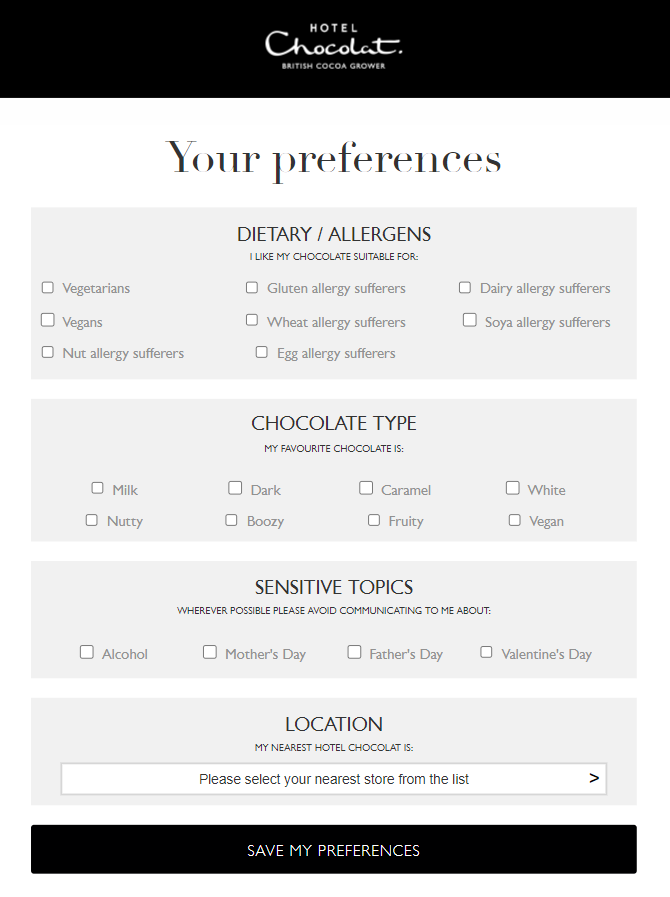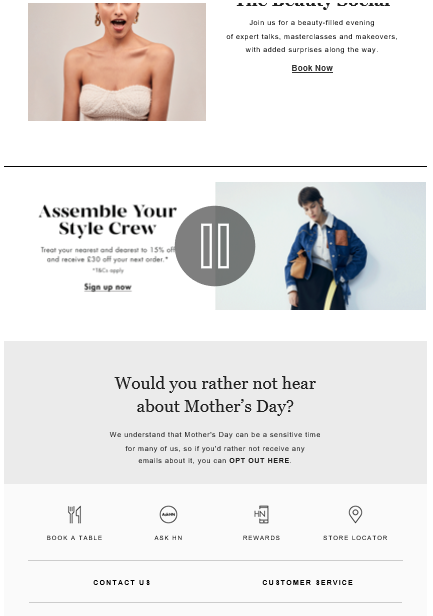Opt-out campaigns: more harm than good?


In recent years, opt-out campaigns have greatly increased. Originally sent by online florist Bloom & Wild in 2019, opt-out campaigns are now incredibly common. Opt-out campaigns are sent around sensitive occasions to give recipients a chance to opt-out of any future email campaigns around the date. These days are usually Mother’s Day, Father’s Day and, more recently we’ve seen opt-out campaigns for Valentine’s Day too.
We’re always recommending you get your customers’ preferences in order to deliver tailored communications, so what’s the issue?
Have opt-out campaigns become overkill?
A year ago we asked our LinkedIn audience what they think of opt-out campaigns, and the results were almost 50:50. In theory, they’re great, but in practice they’re almost more bother than the campaigns they seek to shield you from would be. It’s important to only send an opt-out campaign if you’re planning to send more than one campaign for the day itself, or you’re only adding to the noise.
As brands work with different calendars, some opt-out campaigns can start weeks before the potentially upsetting date. If you know Mother’s Day is a sensitive time for you, you can choose to avoid your promotions inbox for the week preceding it. However, with the rise of opt-out campaigns, this is no longer enough, as inboxes can be a reminder of a sensitive occasion every day for weeks.

What’s the solution?
So, you want to deliver relevant campaigns and be emotionally sensitive to your audience, but it seems a lot of people are fed up of opt-out campaigns. What can you do? Let’s look at a few things you can do to be a part of the next phase of opt-out marketing.
Utilize your preference center
Utilize your preference center year-round. Include opt-out options for sensitive occasions in your general preference center. Often the occasion won’t feel as sensitive if you do them all in one go upon signup, and this also ensures you won’t need to send out any campaigns on the topic, as you already have the data.
These examples from Bloom & Wild and Hotel Chocolat are great examples of preference centers and should be the norm moving forward. This year I’ve received lots of opt out campaigns and the majority of those didn’t include a link to a preference center too. You’d hope these brands are at least storing your response permanently, but I’m sure I’ve opted out of the same brands year after year. This makes for duplicate work, and it’s unnecessary extra emotion for your customers too.


Don’t make it such a big deal
If you do want to send out opt-out campaigns, consider making it a feature of a BAU campaign, a block or banner, rather than the entire focus of the email. Emails solely focused on opting out, in a design similar to the actual emails would be, are more upsetting than they need to be.
This email from Harvey Nichols is all about its Beauty Month takeover, towards the end of the campaign a subtle and discreet Mother’s day opt-out block is present. Of course, you want to ensure people who want to opt-out have the option, so there’s a balance between singing and shouting about it, and still giving people the option.

Create sensitive campaigns
Recognizing that an occasion can be sensitive for your customers is important, and an opt-out campaign isn’t the end of that required sensitivity. When you’re creating campaigns for these occasions, consider the audience that this is hard for. Seeing inclusive and broad language such as mother figures, step mothers, grandmothers, and so on help to soften the sensitivities for some people.
Opting out of emails is just some of the marketing around the day people will see. You can’t opt-out of social media, tv adverts, in-store posters and so on. You also need to be aware that not everyone who finds the day hard will have opted-out. You can stand out by making your email campaign a safe space within a sensitive topic.
Find a way to put a positive spin on it for those who don’t or can’t celebrate. Include some inclusive, uplifting copy in your campaign such as ‘and for those of you who find this day hard, treat yourself, we’re celebrating you’. For those who have opted-out, create a separate content led campaign with no mention of the day at all – so that they don’t feel forgotten, and have a happy distraction on a day where they might be hurting. Empathetic marketing is on the up, and it’s nice to be nice.
This example from kitchenware brand Our Place handles Father’s Day in a fantastic way. The brand hasn’t shied away from the day, but instead handled it with sensitivity and a sense of realness. Featuring a personal story from someone with an absent father, it gives comfort and company to anyone also facing that and finding the day difficult. I also love the line of copy: “To everyone who fills a father’s shoes, we wish you a very happy and restorative Father’s Day” – it’s the perfect example of inclusive language and empathetic marketing.

Summary
Hallmark holidays are big sales opportunities, and they’re opportunities for your brand to demonstrate empathetic marketing too. These days can be incredibly hard for some people for all sorts of reasons. As a brand, the last thing you want your email campaign to do is ruin your customer’s day. Your customer’s experience is priority, and more than ever for these occasions there is no one-size-fits-all approach.
With a bit of forward planning, and a considerate preference center you can deliver sensitive campaigns (or not), without asking your customers each year. Delivering a positive experience and making your customers feel cared for has never been more important. Luckily we do have the tools to do just that. It’s time to be a little more sophisticated for this next stage of opt-out marketing.

